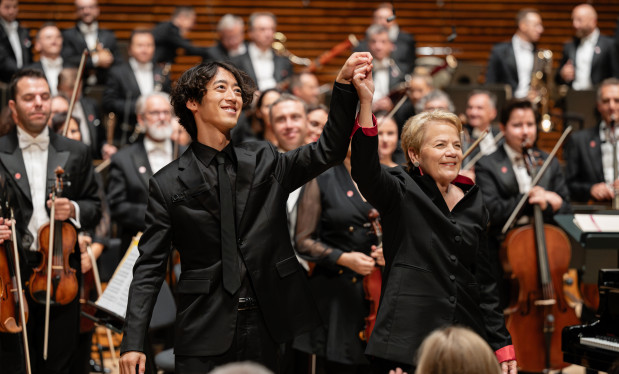NOSPR / Hermus / Great symphonists and The Master-Singers of Nuremberg - NOSPR
NOSPR / Hermus / Great symphonists and The Master-Singers of Nuremberg
If The Master-Singers of Nuremberg were stripped of their stage design and historical setting, they could constitute a metaphor of perfect order in the musical (though not only) world: the winner of the competition for the most beautiful song and its best performance would be the best and the most talented participant and the ambitious mediocre one would suffer a well-deserved defeat. In such a world, the following question would become an abstract and groundless one: why have Henryk Mikołaj Górecki’s Three Dances, Op. 34, not found their rightful place in the concert repertoire? Why is this work – chronologically placed halfway between Symphony No. 2 and No. 3, surprising, brilliant, written with a particular flair for timbre and expression – performed so rarely? Nonetheless, in real life, Walter’s love song does not shine in a blaze of glory at first, while the talentless Beckmesser will still trumpet his clerkish shallowness before he finally loses.
Usually, however, it is the greatness of vision that wins. Such was the Wagnerian vision, which changed the course of history. Without his orchestral language, Bruckner’s, Mahler’s and Richard Strauss’ oeuvres would certainly be different from those we know today.
In his Gesamtkunstwerk, Wagner lent an increasingly greater weight to the orchestra. The instrumental layer ceases to be merely a helpful scaffolding for the vocal show, beginning to explain and add to the drama happening onstage. The furthest he ever ventured away from the academic thinking about form was in the prelude to the Lohengrin (1848). In the prelude to the 1862 Die Meistersinger von Nürnberg, Wagner decided to build a classically structured score. In a sophisticated manner, he brings together motifs taken from the operatic plot, referencing its heroes and crucial moments, simultaneously creating a score of unusual brilliance and elan, a concert masterpiece.
Even though Bruckner admired Wagner, the path his symphonies open up for us is one leading to a radically different sphere of artistic expression – a sphere marked by patience and humility, but also by self-destructive uncertainty. In this Brucknerian world, The Sixth is truly exceptional. The least frequently performed, it does not belong to any period – while being the only one never amended by the composer, it also separates the “early” part of his symphonic universe from the “late” works. Amidst contrasting moods and motifs, the meandering harmonies, complicated rhythms and an orchestration fueled by an unrestrained imagination lead from darkness to light.
Andrzej Sułek
Concert duration (intermission included): approximately 100 minutes
Upcoming events

Japan tournée / NOSPR / Marin Alsop / Hayato Sumino / Masaya Kamei
Tokyo Opera City

Japan tournée / NOSPR / Marin Alsop / Hayato Sumino
Toyama, Aubade Hall

Japan tournée / NOSPR / Marin Alsop / Hayato Sumino
Osaka, The Symphony Hall

Japan tournée / NOSPR / Marin Alsop / Hayato Sumino
Kurashiki Shimin Hall

Japan tournée / NOSPR / Marin Alsop / Hayato Sumino
Yokohama, Minato Mirai Hall

Japan tournée / NOSPR / Marin Alsop / Hayato Sumino
Tokio, Suntory Hall

Japan tournée / NOSPR / Marin Alsop / Hayato Sumino
Nagoya, Aichi Prefectural Art Theater

Japan tournée / NOSPR / Marin Alsop / Hayato Sumino
Tokorozawa Muse

Japan tournée / NOSPR / Marin Alsop / Hayato Sumino
Chiba, Ichikawa Shimin Hall

Japan tournée / NOSPR / Marin Alsop / Hayato Sumino
Shizuoka, Act City Hamamatsu




